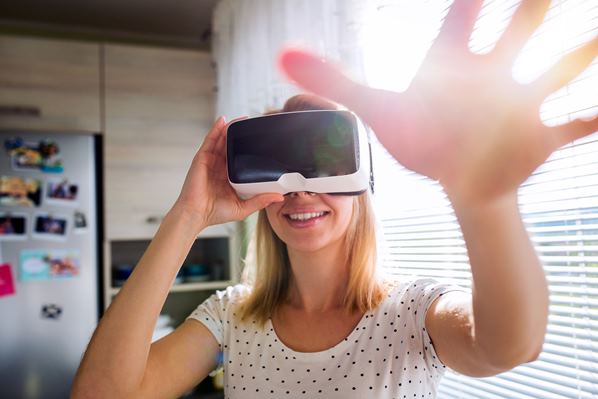
Some exciting trends are emerging in the world of Mixed Reality (MR) that could have a major impact on the online customer experience of the future.
MR encompasses a range of technologies that combine the digital and natural worlds. Augmented Reality (AR) functions in a real-world environment and overlays computer graphics you can see and manipulate using smartphones or glasses, while Virtual Reality (VR) creates a digital, simulated environment you can explore and interact with using a headset.
Early VR gaming headsets appeared in the 1990s and the technology has taken leaps and bounds since then. The first commercial application of AR occurred in 2008 in the form of a BMW magazine ad readers could augment using a computer camera. With 5G speeds driving the growth of new MR products, the global AR/VR market is forecast to reach $18.8 billion in 2020.
Businesses are now creating applications in a wide range of areas, often with the assistance of software development companies like BairesDev. In fact, 87% of respondents to a Harvard Business survey reported that they’re exploring, piloting, or currently deploying MR.
Here are some of the MR trends you can expect to see in the next few years.
Better Navigation
You probably already use Google and Apple map services to guide outdoor navigation, but did you know that AR technology can assist your indoor navigation? AR smartphone apps can help you find your way around complex locations like airports, hospitals, malls, and office buildings, saving you time and effort. For example, Gatwick Airport in London offers AR apps to help travelers get to the right terminals and gates, and find baggage carousels, check-in desks, and restaurants.
Advancing outdoor navigation, Google is beta testing AR walking directions for Google Maps on AR-compatible mobile devices, allowing you to see overlaid information about things around you in real-time. Automobile manufacturers are using AR cameras and dashboard displays to help you navigate around safety hazards and receive information about nearby attractions.
Improved Wearables
The primary wearable device used for AR is currently “smart glasses” (though you can also access the technology through mobile devices and desktops). VR is typically experienced through headsets. These wearables are getting smaller and lighter, making them more comfortable to use.
Prices will continue to drop, expanding access to even more consumers, while processing power and battery life will increase. Your VR experiences will be more satisfying with higher quality, wireless headsets that display higher resolution graphics. VR headsets out now include Oculus Quest, Valve Index, and Vive Cosmos.
Enhanced Online Shopping
No matter how convenient, online shopping has always lacked the hands-on benefits of interacting with objects in a retail store. Companies are now using AR technology to allow you to engage with products in virtual showrooms, or place them virtually in your home, to help you better imagine using them before buying.
Take IKEA’s Place app for example. This app lets you point your phone at spaces to see what furniture would look like in your home. Makeup companies offer AR technology that adapts to at-home lighting conditions to provide you with personalized product recommendations without leaving your house. Additional online shopping applications include:
- 3D room design for kitchens, bathrooms, and home goods
- 3D visualization to enable remote interior design services
- AR apps to browse products
More Exciting Games
Online gaming is where MR got its start, and developments continue in this arena. The expansion of 5G will allow more advanced mobile gaming, such as multi-user experiences with hundreds of users viewing and changing 3D content in real-time without lag. You can also expect to find smarter, AI-driven opponents when you play. Innovative VR games coming in 2020 include:
- “Half-Life Alyx,” a prequel to Half-Life 2 about a hacker about to start a revolution against an alien force, was built from the ground up specifically for VR.
- “Walking Dead: Saints & Sinners,” an open-world choose-your-own-path adventure, uses a new VR physics system that allows visceral hand-to-hand combat you can physically feel.
Targeted Marketing
You should start seeing more businesses use MR technology in marketing efforts, which will help you understand advertised products more thoroughly, often through virtual “hands-on” experiences. Two industries in particular, real estate and tourism, are effectively utilizing this technology.
Real Estate
Visualize yourself in various homes or apartments through virtual tours and immersive 360-degree videos.
- Explore properties for sale anywhere in the world without physically traveling there.
- Place virtual furniture throughout properties, to better imagine living there, using an AR home staging app like the one Sotheby’s offers.
Tourism
- Experience potential travel destinations through VR to help you decide where to take a trip.
- Re-experience your trips through VR after you return.
In Summary
As prices come down and technology continues to improve, you can expect to see MR expanding into more areas of life. Keep an eye out for new opportunities to use AR and VR to shop online more efficiently, quickly navigate airports and malls, and choose with confidence where to take your next big trip.
About the Author
Malcom Ridgers is a tech expert at BairesDev specializing in the software outsourcing industry. He has access to the latest market news and has a keen eye for innovation and what’s next for technology businesses.




